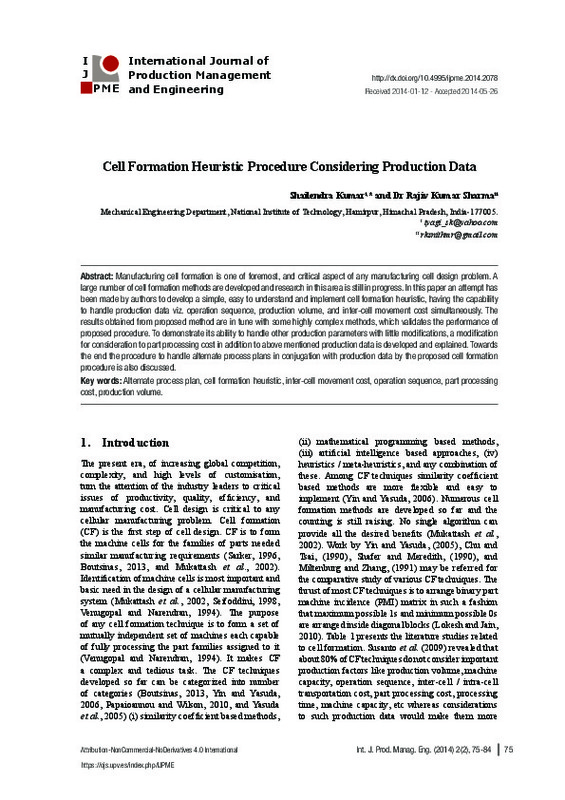Ahi, A., Aryanezhad, M. B., Ashtiani, B., & Makui, A. (2009). A novel approach to determine cell formation, intracellular machine layout and cell layout in the CMS problem based on TOPSIS method. Computers & Operations Research, 36(5), 1478-1496. doi:10.1016/j.cor.2008.02.012
Arkat, J., Hosseinabadi Farahani, M., & Hosseini, L. (2011). Integrating cell formation with cellular layout and operations scheduling. The International Journal of Advanced Manufacturing Technology, 61(5-8), 637-647. doi:10.1007/s00170-011-3733-4
Beaulieu, A., Ait-Kadi, D., & Gharbi, A. (1993). Heuristic for Flexible Machine Selection Problems. Journal of Decision Systems, 2(3-4), 241-253. doi:10.1080/12460125.1993.10511583
[+]
Ahi, A., Aryanezhad, M. B., Ashtiani, B., & Makui, A. (2009). A novel approach to determine cell formation, intracellular machine layout and cell layout in the CMS problem based on TOPSIS method. Computers & Operations Research, 36(5), 1478-1496. doi:10.1016/j.cor.2008.02.012
Arkat, J., Hosseinabadi Farahani, M., & Hosseini, L. (2011). Integrating cell formation with cellular layout and operations scheduling. The International Journal of Advanced Manufacturing Technology, 61(5-8), 637-647. doi:10.1007/s00170-011-3733-4
Beaulieu, A., Ait-Kadi, D., & Gharbi, A. (1993). Heuristic for Flexible Machine Selection Problems. Journal of Decision Systems, 2(3-4), 241-253. doi:10.1080/12460125.1993.10511583
Beaulieu, A., Gharbi, A., & Ait-Kadi. (1997). An algorithm for the cell formation and the machine selection problems in the design of a cellular manufacturing system. International Journal of Production Research, 35(7), 1857-1874. doi:10.1080/002075497194958
Boutsinas, B. (2013). Machine-part cell formation using biclustering. European Journal of Operational Research, 230(3), 563-572. doi:10.1016/j.ejor.2013.05.007
Chow, W. S., and Hawaleshka, O., (1992), An efficient algorithm for solving the machine chaining problem in cellular manufacturing, Computers ind. Engng., Vol. 22, No. 1, 95-100.
CHU, C.-H., & TSAI, M. (1990). A comparison of three array-based clustering techniques for manufacturing cell formation. International Journal of Production Research, 28(8), 1417-1433. doi:10.1080/00207549008942802
Nair, G. J., & Narendran, T. T. (1998). CASE: A clustering algorithm for cell formation with sequence data. International Journal of Production Research, 36(1), 157-180. doi:10.1080/002075498193985
Jie Lian, Chen Guang Liu, Wen Juan Li, Steve Evans, Yong Yin, (2013), Formation of independent manufacturing cells with the consideration of multiple identical machines, International journal of production research, Kim, C. O.,Baek, J. G., Baek, J. K., (2004), A two-phase heuristic algorithm for cell formation problems considering alternative part routes and machine sequences, International Journal of Production Research, 42:18, 3911-3927,
Krushinsky, D., & Goldengorin, B. (2012). An exact model for cell formation in group technology. Computational Management Science, 9(3), 323-338. doi:10.1007/s10287-012-0146-2
Kumar, L. (2008). Part-machine group formation with operation sequence, time and production volume. International Journal of Simulation Modelling, 7(4), 198-209. doi:10.2507/ijsimm07(4)4.113
Lokesh, K., & Jain, P. K. (2010). Concurrently part-machine groups formation with important production data. International Journal of Simulation Modelling, 9(1), 5-16. doi:10.2507/ijsimm09(1)1.133
Miltenburg, J., & Zhang, W. (1991). A comparative evaluation of nine well-known algorithms for solving the cell formation problem in group technology. Journal of Operations Management, 10(1), 44-72. doi:10.1016/0272-6963(91)90035-v
Mukattash, A. M., Adil, M. B., & Tahboub, K. K. (2002). Heuristic approaches for part assignment in cell formation. Computers & Industrial Engineering, 42(2-4), 329-341. doi:10.1016/s0360-8352(02)00020-7
Mahesh, O., & Srinivasan, G. (2002). Incremental cell formation considering alternative machines. International Journal of Production Research, 40(14), 3291-3310. doi:10.1080/00207540210146189
Sudhakara Pandian, R., & Mahapatra, S. S. (2009). Manufacturing cell formation with production data using neural networks. Computers & Industrial Engineering, 56(4), 1340-1347. doi:10.1016/j.cie.2008.08.003
Papaioannou, G., & Wilson, J. M. (2010). The evolution of cell formation problem methodologies based on recent studies (1997–2008): Review and directions for future research. European Journal of Operational Research, 206(3), 509-521. doi:10.1016/j.ejor.2009.10.020
Sarker, B. R., (1996), The resemblance coefficients in group technology: a survey and comparative study of relational metrics, Computers ind. Engng., Vol. 30, No. 1, 103-116.
Seifoddini, H., (1998), Comparison between single linkage and average linkage clustering techniques in forming machine cells", Computers & industrial engineering 15(14), 210-216.
SHAFER, S. M., & MEREDITH, J. R. (1990). A comparison of selected manufacturing cell formation techniques. International Journal of Production Research, 28(4), 661-673. doi:10.1080/00207549008942747
VENUGOPAL, V., & NARENDRAN, T. T. (1994). Machine-cell formation through neural network models. International Journal of Production Research, 32(9), 2105-2116. doi:10.1080/00207549408957061
Won, Y., & Lee, K. C. (2001). Group technology cell formation considering operation sequences and production volumes. International Journal of Production Research, 39(13), 2755-2768. doi:10.1080/00207540010005060
Yasuda *, K., Hu, L., & Yin, Y. (2005). A grouping genetic algorithm for the multi-objective cell formation problem. International Journal of Production Research, 43(4), 829-853. doi:10.1080/00207540512331311859
Yin, Y., & Yasuda, K. (2005). Similarity coefficient methods applied to the cell formation problem: a comparative investigation. Computers & Industrial Engineering, 48(3), 471-489. doi:10.1016/j.cie.2003.01.001
Yin, Y., & Yasuda, K. (2006). Similarity coefficient methods applied to the cell formation problem: A taxonomy and review. International Journal of Production Economics, 101(2), 329-352. doi:10.1016/j.ijpe.2005.01.014
[-]








